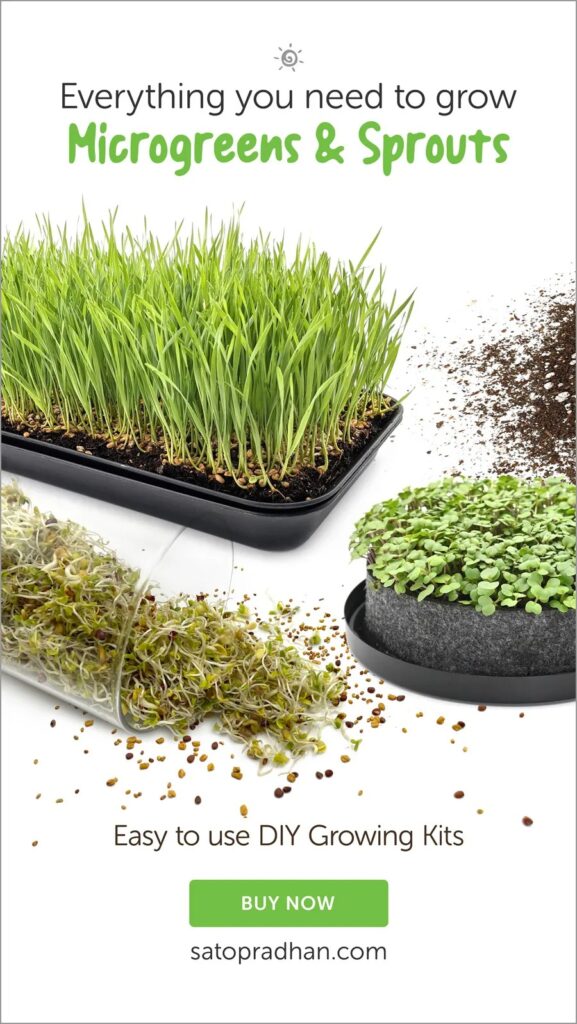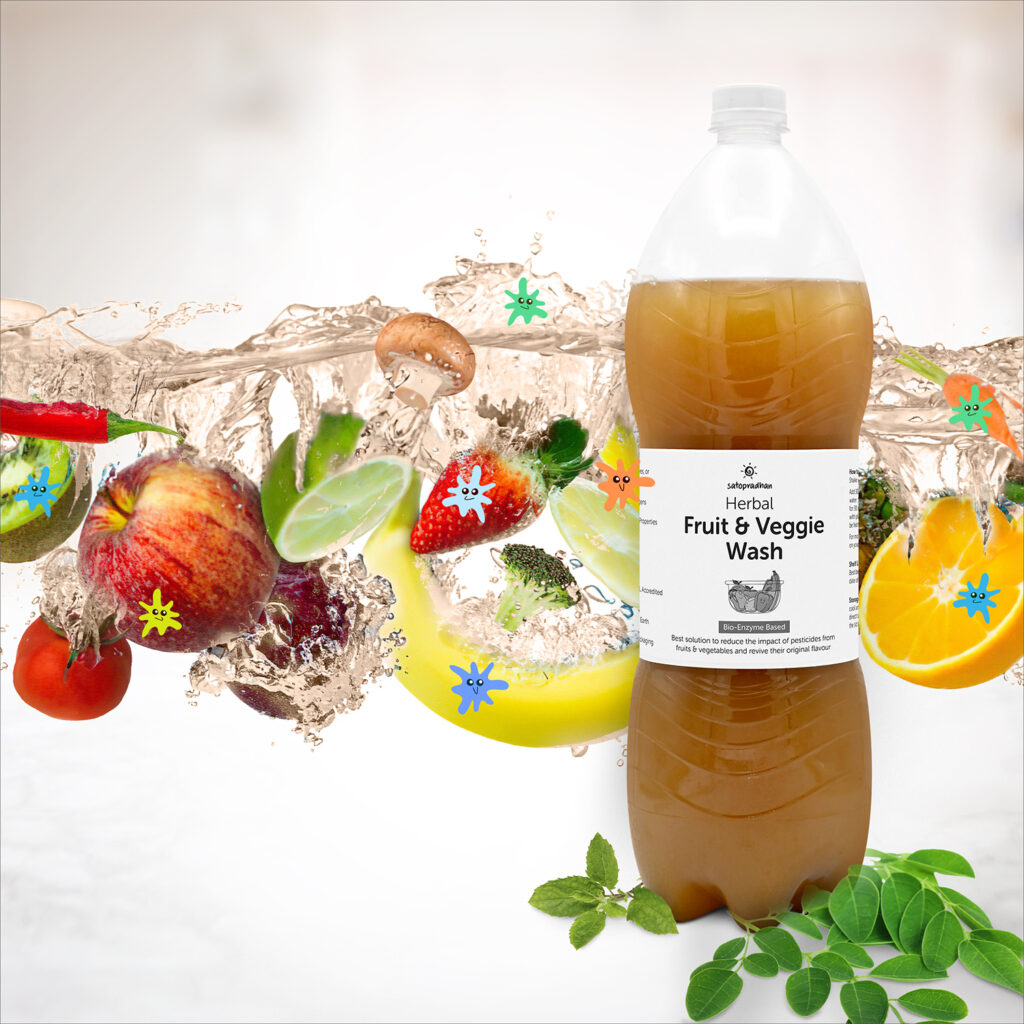
Ever wondered that you could grow your green thumb just with a tray, soil and seeds?
Yes, it is possible as you start growing microgreens- the best way to experience the joy of growing indoors & eating living foods all year long!!
What are Microgreens?
During the journey of seed germination, the seed first develops its primary roots & is known as a sprout; then, in the next stage, its first two leaves appear, which are called cotyledons or seed leaves. At this stage of growth, the plant is called a microgreen.
This stage of plant life is when it needs the most nutrition (40 times more than its mature counterparts) & is packed with essential nutrients. The cotyledons help supply the food a plant embryo needs to germinate. Microgreens are ready to harvest when they are 2” to 3” long.
So, a microgreen is the immature, tiny edible plant harvested with scissors or a knife within two to three weeks after germination when the plants are up to 2-4 inches tall; it is everything we see above the soil and consume it from stem to leaves. This is one of the things you can grow no matter where you live.
Benefits of Microgreens
These teeny-tiny greens are full of nutrition as they
- Help fight off diseases as they are rich in antioxidants
- Contain high beta carotene levels which are essential building blocks for our bodies
- Provide essential skin nutrients such as zinc & polyphenols with anti-inflammatory properties
- Repair damaged hair due to the presence of nutrients like iron and potassium
- Facilitate weight loss as they are rich in dietary fibre & low-calorie content
Why Grow Microgreens?
Apart from being a powerhouse of nutrition, there are several reasons to grow & incorporate these small but mighty greens into your daily diet. Some of the many reasons are that they are:
- Quick & easy to grow
- Best suited for a quick harvest
- Perfect for people with limited space & time for a garden
- Suitable for all climates
- Available in a variety of colour & texture
- Delicious, having an intense aromatic flavour
- Grown with minimal equipment, time & effort
Types of Microgreens
Many vegetables, leafy greens, herbs, or flowers can be grown as microgreens, but some are more suitable than others. Some of the best and popular types of microgreens that can be grown from seeds are:
- Brassicas like mustard, broccoli, knol-khol, cauliflower & other vegetables like peas, beetroot, turnip & radish etc.
- Herbs & leafy greens like spinach, coriander, amaranthus, lettuce, fenugreek etc.
- Grasses & Cereals like wheat, oats, barley, rice & legumes like chickpeas, lentils, beans etc.
- Forage crops like alfalfa & clover.
- Edible Flowers like borage, sunflower, nasturtium, chives or lavender.
- Shoots like peas, sunflower & corn.
What do You need to Grow Microgreens?
Microgreens are easy and quick to grow at home. They are ideal for you if you struggle with time and space for your garden but want to start eating healthy. Let’s break down exactly what you need to start growing microgreens at home. You will need
- Organic microgreen seeds
- Growing trays
- Growing media
- Spray bottle or watering can
- Well-lit location
Method to Grow Microgreens
Through the growing period, the microgreens go through three phases. Once you have gathered all the supplies you need, here’s how to grow them.
Germination phase or Blackout period
Cover the Seeds
Now cover the seeds with a very thin layer of soil & gently pat the surface to make the seeds settle well in the tray. Give it a very light mist over the top just enough to get the surface wet so as to trigger the germination process
Cover the Tray
Use another tray without drainage holes or any other opaque object to cover this tray to maintain darkness & provide a little bit of pressure that will help bury them under the soil. This is also known as the blackout period
Growing Phase
Uncover the seeds and secure a Location
When the seeds have germinated (approximately after 2-3 days), remove the tray from above and keep them near a window where it gets 3-4 hours of direct sunlight.
Water as needed
Mist them twice a day during summers and less frequently during winters to maintain appropriate moisture. For best results, bottom watering is suggested
Harvest Phase
Harvest your greens
Mist them twice a day during summers and less frequently during winters to maintain appropriate moisture. For best results, bottom watering is suggested
Store your greens
Place them in an airtight container & store them in the refrigerator for up to a week.
Are microgreen seeds different from normal seeds?

No, special seeds are not required for growing microgreens. These are the same exact variety that you would use to produce the standard full-grown vegetables for your home garden.
Microgreens can be grown from any variety of seed but some seeds are more suitable to be grown as microgreens than others. But it is essential to choose the seeds from a trusted source as microgreens are especially sensitive to the seed quality as you are harvesting it at such a high density and at such an early phase of a plant’s life. ensures its high germination rate & absence of any chemical treatment. Seeds used for edible microgreen should themselves be organic no matter if its growing method is organic or not certified organic or certified naturally grown.
At Satopradhan we provide different seeds categories for sprouts and microgreens due to their larger packaging quantity as compared to other seeds; the variety of the seeds is the same except for the fact that we plant them more densely than we normally would.
After conducting a lot of research, we have sourced these high-quality, 100% organic desi seeds which are just not organically grown but saved & handed down through generations while preserving the unique qualities of plants they produce. Seed packets offered by satopradhan provides you with detailed & authentic information like the variety of seeds and step by step guidance on how to grow sprouts and microgreens which may be helpful to make your indoor gardening a success:)
Microgreens versus Sprouts

Oh No..No, they are not sprouts. Microgreens and sprouts may look similar, but they are different phases of a plant’s life. They differ from each other on the following points.
- Sprouts are the first and foremost stage of a plant’s life, i.e. 2 to 4 days of growth after germination, whereas microgreens are the intermediate stage between the sprouts and baby greens & they grow in about 7 to 14 days.
- In the sprouting stage, the seed develops its primary roots, whereas a microgreen grows its roots, stems & seed leaves.
- Sprouts & microgreens are equally nutritious and cannot be compared as sprouts are a rich source of amino acids & protein. Microgreens are rich in chlorophyll & polyphenols, i.e. antioxidants linked to lower the risk of chronic diseases.
- Sprouts are germinated in the water while microgreens are grown in soil. You can harvest the sprouts when the seed leaves are still underdeveloped and harvest the microgreens with the emergence of leaves.
- Sprouts are consumed as an entire plant, including the root, seed and shoot, whereas as in microgreens, everything above the soil, i.e. stems, seed leaves and true leaves, are consumed.
How to Use Microgreens

These nutrient-packed tiny plants can be consumed as it is or used
- As a garnish for salads, soups and lettuce wraps
- As a side dish to any meal
- As an added nutrition to smoothies, soups & juices
Microgreens can be eaten raw or cooked. They are best when consumed raw as they lose their nutritional value & leads to changed texture and flavour when cooked. You can add them to your meals at the last minute after turning off the stove and slightly cook them in steam.
So
Are you ready for a healthy beginning to a nutritious life?'[
You can now shop these easy and quick to grow varieties of microgreen seeds from our online store.
Do not forget to always use a non-contaminated & 100% organic growing medium to grow your microgreens.
Confused about where to find it?
These nutrient-packed tiny plants can be consumed as it is or used
After conducting a dozen experiments on growing microgreens in different mediums, we have found the best growing medium for you to start with. Visit https://satopradhan.com/collections/soil-care/products/seeds-starter-mix to get 100% organic soilless seed starter mix perfect for seed germination.
Happy Gardening 🙂







